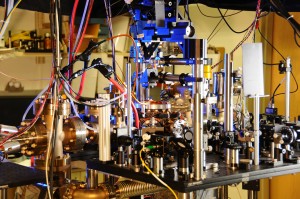If you use a cellular telephone or a GPS, you are using a piece of digital consumer electronics tied to the world’s most precise and stable time standards. The current standard for precision is the NIST-F1 Cesium Fountain Clock. This precision is important, because it helps make that digitized cellular telephone conversation intelligible, and it gives accuracy and consistency to the positioning of GPS receivers.
Now physicists at the National Institute of Science and Technology have developed the Ytterbium Atomic Clock (shown left). Its “ticks” are of almost the same duration; they are stable to within less than two parts in 1 quintillion (1 followed by 18 zeros). Ytterbium is the 70th element in the periodic table of elements.
It is the ability to synchronize the various electronic clocks with the NIST time standard that enables your GPS to find that spot where you caught the big fish last week.

